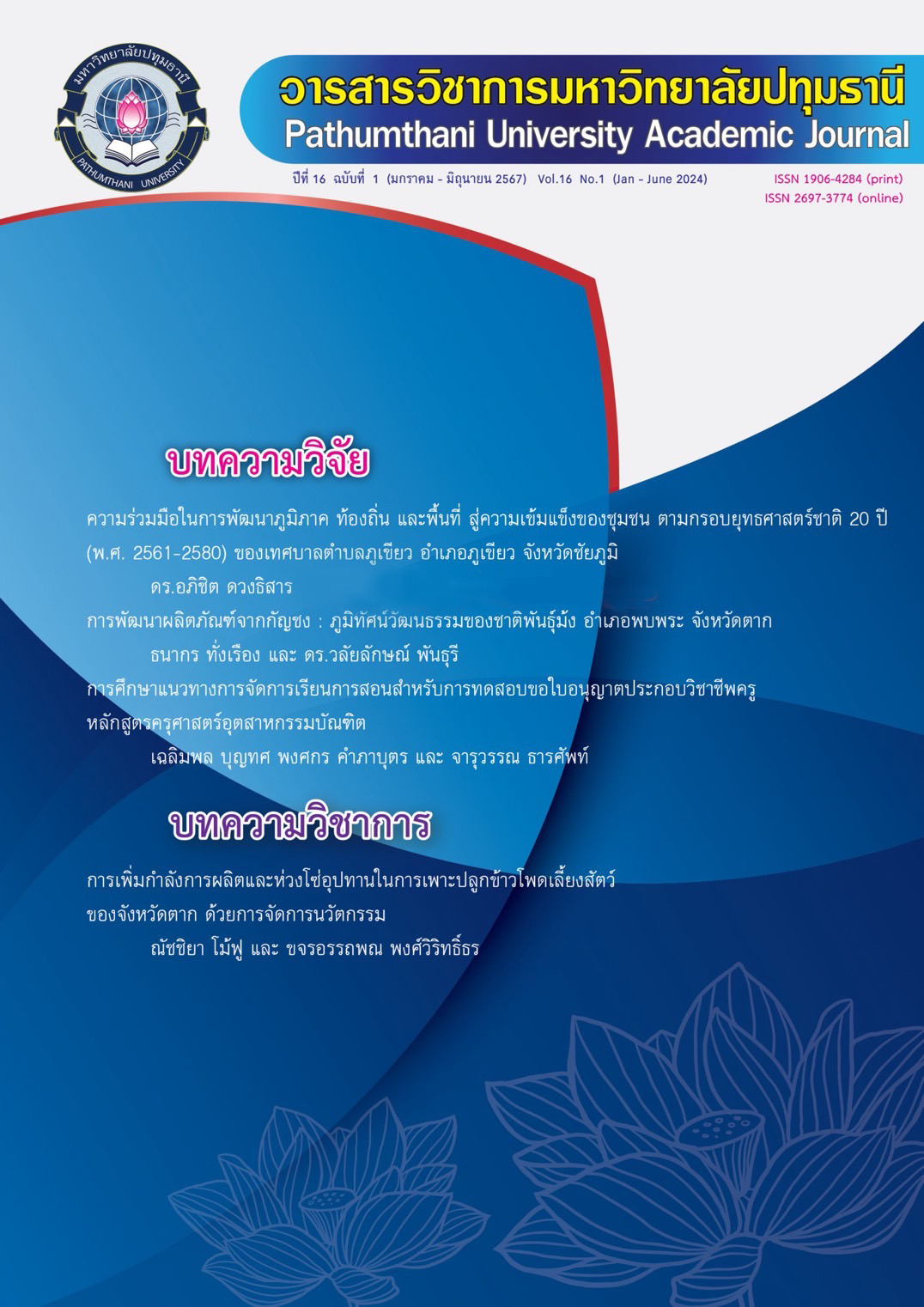COMMUNITY PARTICIATION IN DEVELOPING TOUISM POTENTIAL AT DOI MUSER MAE SOT DISTRICT, TAK PROVINCE
Keywords:
Community Participation , Tourism Potential , Doi Muser, Mae Sot District, Tak ProvinceAbstract
The objectives of this research 1) Study guidelines for developing tourism potential at Doi Muser. 2) Study participation and the level of community participation in sustainable tourism management. It is mixed methods research with interviews with informants, namely government groups, community leaders. community member group Entrepreneur group and the population living in the community, the population was 720 people, the sample population was 253 people, content analysis Analyze the average and standard deviation.
The research results found that Guidelines for developing tourism potential at Doi Muser, Mae Sot District, Tak Province. The community has the potential to develop tourism. Due to the abundance of natural resources such as Muser Waterfall, Doi Sian viewpoint, Doi Mae Mai, avocado orchards, cabbage farms, strawberry farms, etc. In addition, the cultural way of the Muser ethnicity reflects their identity in both their dress. local food and way of life can be developed into strategies: 1) Proactive strategy: increase community potential Develop learning activities Support local industry 2) Corrective strategy: Pursue knowledge. Cultivate an attitude Be one in the community 3) Preventive strategies: Promote awareness Preserve arts and culture 4) Defensive strategy: Create a flower garden. Promote and preserve nature Waterfall type, view at Muser It can be used to plan, policy, and determine strategies for developing tourism potential to support the expansion of the border tourism economy. It aims to raise the quality of life of people in the grassroots community in economic, social, cultural and environmental dimensions in a sustainable way based on the identity of Doi Muser, Mae Sot District, Tak Province. 2) Community participation in tourism development Overall, it is at a high level. Respondents had a high level of opinion regarding community participation as a whole (mean = 3.55).
References
กรมการพัฒนาชุมชน. (2561). คู่มือการบริหาร โครงการหมู่บ้าน OTOP เพื่อการท่องเที่ยว (OTOP Village) 8 เส้นทาง. กรุงเทพมหานคร : กระทรวงมหาดไทย.
กรมการพัฒนาชุมชน. (2561). หลายเสน่ห์หลาก ผลิตภัณฑ์คู่มือการดำเนินงานโครงการ หมู่บ้าน OTOP เพื่อการท่องเที่ยว (OTOP Village) 8 เส้นทาง. กรุงเทพมหานคร.
กรมการพัฒนาชุมชน. (2561). เปิดมิติใหม่ หมู่บ้าน OTOP เพื่อการท่องเที่ยว. [ออนไลน์]. เข้าถึงได้จาก: https://www.ryt9.com/s/prg/2880976 เมื่อวันที่ 20 มีนาคม 2562.
การท่องเที่ยวแห่งประเทศไทย. (2560). ททท. ตอบโจทย์ท่องเที่ยวชุมชน. [ออนไลน์]. เข้าถึงได้จาก https://www. thairath.co.th/content/1110939 เมื่อวันที่ 20 สิงหาคม 2561.
การพัฒนาการท่องเที่ยว แบบยั่งยืน. กรุงเทพมหานคร : เพรส แอนด์ ดีไซน์.ปรัชญากรณ์
กุสุมา ผลาพรม และคณะ. (2561). “การพัฒนาธุรกิจชุมชนพื้นที่สูงอย่างยั่งยืน : กรณีศึกษากลุ่มชาติพันธ์ชาวไทยภูเขาเผ่ามูเซอ จังหวัดตาก” วารสารวิชาการมหาวิทยาลัยราชภัฎเพชรบุรี. ปีที่ 8 ฉบับที่ 3. (กันยายน-ธันวาคม 2561).
ชมพูนุท ภาณุภาส และคณะ. (2564). “ศักยภาพการท่องเที่ยวเชิงอาหารตามอัตลักษณ์พื้นที่นครแม่สอด จังหวัดตาก”. วารสารมหาวิทยาลัยคริสเตียน. ปีที่ 27 ฉบับที่ 2. (เมษายน-มิถุนายน 2564).
ฐิตาภา บํารุงศิลป์. (2565). “การมีส่วนร่วมของชุมชนในการพัฒนาศักยภาพการท่องเที่ยว ชุมชนบ้านวังรี จังหวัดนครนายก”. วารสารวิทยาการจัดการ คณะวิทยาการจัดการ มหาวิทยาลัยราชภัฎพิบูลสงคราม. ปีที่ 3 ฉบับที่ 3. (กันยายน-ธันวาคม 2564).
รุ่งราตรี อึ้งเจริญ และ ชวลีย์ ณ ถลาง. (2560). “การศึกษาศักยภาพการท่องเที่ยวเชิงนิเวศของ จังหวัดสมุทรสาคร”. วารสารวิทยาลัยดุสิตธานี. ปีที่ 11 ฉบับที่ 1. หน้า 133-148.
Yamane, Taro. (1976). Statistics: An introductory analysis. (2nd ed.). New York: Harper and Row.
Likert, R. (1967). "The Method of Constructing and Attitude Scale," in Attitude
Theory and Measurement. New York : Wiley & Son.
Downloads
Published
How to Cite
Issue
Section
License
Copyright (c) 2024 ATCHASIT ANKINANDANA

This work is licensed under a Creative Commons Attribution-NonCommercial-NoDerivatives 4.0 International License.
บทความที่ได้รับการตีพิมพ์เป็นลิขสิทธิ์ของวารสารมหาวิทยาลัยปทุมธานี
ข้อความที่ปรากฎในบทความแต่ละเรื่อง เป็นความคิดเห็นส่วนตัวของผู้เขียน กองบรรณาธิการไม่จำเป็นต้องเห็นด้วยเสมอไป และไม่มีส่วนรับผิดชอบใด ๆ ถือเป็นความรับผิดชอบของผู้เขียนแต่เพียงผู้เดียว



